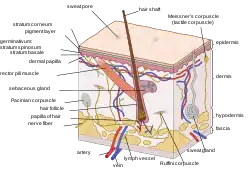پوست انسان
پوست انسان، پوشش بیرونی بدن و بزرگترین اندام دستگاه پوششی میباشد. پوست از هفت لایه بافت اکتودرمی تشکیل شده و از ماهیچهها، استخوانها، رباطها و اندامهای داخلی محافظت میکند.[1] پوست انسان مشابه پوست اکثر پستانداران بوده و بسیار شبیه پوست خوک است.[2][3] گرچه که تقریباً پوست تمام انسانها با فولیکولهای مو پوشیده شده، اما ممکن است بدون مو ظاهر شود. میتوان پوست را به دو دسته عمومی تقسیمبندی کرد: پوست مودار و بدون مو.[4] صفت cutaneous (از ریشه لاتین cutis به معنای پوست) به صورت تحتاللفظی به معنای «مربوط به پوست» است.
| پوست | |
|---|---|
 | |
| جزئیات | |
| دستگاه | دستگاه پوششی |
| شناسهها | |
| لاتین | کوتیس |
| MeSH | D012867 |
| TA98 | A16.0.00.002 |
| TA2 | 7041 |
| TH | H3.12.00.1.00001 |
| FMA | 7163 |
منابع
- "Skin care" (analysis), Health-Cares.net, 2007, webpage: HCcare بایگانیشده در ۱۲ دسامبر ۲۰۰۷ توسط Wayback Machine
- Herron AJ (5 December 2009). "Pigs as Dermatologic Models of Human Skin Disease" (PDF). ivis.org. DVM Center for Comparative Medicine and Department of Pathology Baylor College of Medicine Houston, Texas. Retrieved 27 January 2018.
pig skin has been shown to be the most similar to human skin. Pig skin is structurally similar to human epidermal thickness and dermal-epidermal thickness ratios. Pigs and humans have similar hair follicle and blood vessel patterns in the skin. Biochemically pigs contain dermal collagen and elastic content that is more similar to humans than other laboratory animals. Finally pigs have similar physical and molecular responses to various growth factors.
- Liu J, Kim D, Brown L, Madsen T, Bouchard GF. "Comparison of Human, Porcine and Rodent Wound Healing With New Miniature Swine Study Data" (PDF). sinclairresearch.com. Sinclair Research Centre, Auxvasse, MO, USA; Veterinary Medical Diagnostic Laboratory, Columbia, MO, USA. Retrieved 27 January 2018.
Pig skin is anatomically, physiologically, biochemically and immunologically similar to human skin
- Marks, James G; Miller, Jeffery (2006). Lookingbill and Marks' Principles of Dermatology. (4th ed.). Elsevier Inc. ISBN 1-4160-3185-5.
- مشارکتکنندگان ویکیپدیا. «Human Skin». در دانشنامهٔ ویکیپدیای انگلیسی.
This article is issued from Wikipedia. The text is licensed under Creative Commons - Attribution - Sharealike. Additional terms may apply for the media files.